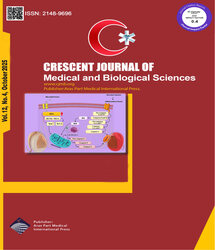

| Original Article | |
| The Relation of Serum Bilirubin Level With Coronary Artery Disease Based on Angiographic Findings | |
| Mohammadreza Taban Sadeghi, Ali Golmohamadi*, Rezayat Parvizi, Naser Kezerlou Aghdam, Ahmad Separham, Zahra Hosnavi | |
| Cardiovascular Research Center, Tabriz University of Medical Sciences, Tabriz, Iran | |
|
CJMB 2015; 2: 130-134 Viewed : 4395 times Downloaded : 4017 times. Keywords : Angiography, Atherosclerosis, Bilirubin, Coronary vessels |
|
| Full Text(PDF) | Related Articles | |
| Abstract | |
Objective: Lipid oxidation and generation of free radicals are important factors contributing to the formation of atherosclerotic plaque. Bilirubin is supposed to play a protective role against atherosclerosis, coronary artery diseases (CAD) and inflammation for its strong antioxidant property. Thus, this study aims at investigating the relationship of bilirubin level with the severity and type of coronary artery stenosis (CAS) in different patient groups. Materials and Methods: In this cross-sectional study 200 consecutive patients, who underwent elective angiography in Madani Heart hospital, Tabriz, Iran, were selected and their blood samples were measured for total, direct, and indirect bilirubin level, with Diazo method using colorimetric technique. Following angiography, comparisons were made between the severity and location of CAS and therapeutic follow-up plan with total, direct, and indirect bilirubin level. Results: Of 200 studied patients, 129 (64.5%) and 71 (35.5%) subjects were male and female, respectively. The cases were classified into 5 subgroups based on angiography results as follows: 59 (29.5%) cases with normal angiography, 11 cases (5.5%) with minimal CAD, 56 cases (28%) with single vessel involvement, 35 (17.5%) cases with two vessel involvement and 39 cases (19.5%) with three vessel involvement. The mean total bilirubin level was 1.47 ± 0.8 mg/dl, 1.27 ± 0.12 mg/dl, 1.27 ± 0.06 mg/dl, 1.6 ± 0.04 mg/dl and 0.98 ± 0.05 mg/dl, respectively for the cases with above order. The mean difference in serum total bilirubin between normal angiography group and three-vessel involvement group was 0.49 mg/dl (P < .0001). There was a significant inverse relation between bilirubin level (total, direct and indirect) and number of involved vessels and involvement intensity increased as serum bilirubin level decreased. Severity of coronary arteries stenosis as well as the number of involved vessels increased as serum bilirubin level decreased. Conclusion: According to results, there was a significant inverse relation between serum bilirubin level and coronary involvement (type and intensity). Higher bilirubin serum levels played a protective role against CAD, even in the presence of other risk factors. Therefore, bilirubin level can be used as a predictor of CAD in the future. |
Cite By, Google Scholar
Google Scholar
PubMed
Online Submission System
 CJMB ENDNOTE ® Style
CJMB ENDNOTE ® Style
 Tutorials
Tutorials
 Publication Charge
Medical and Biological Research Center
About Journal
Publication Charge
Medical and Biological Research Center
About Journal
Aras Part Medical International Press Editor-in-Chief
Arash Khaki
Deputy Editor
Zafer Akan

















